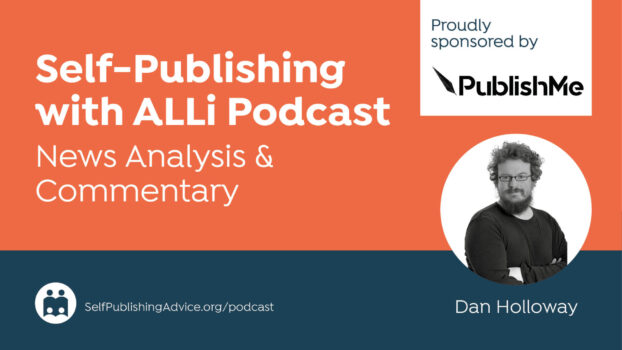“If you could give one piece of marketing advice to authors, what would it be?” I’m often asked this question, and depending on what way the wind is blowing, I might suggest taking a professional approach to your book’s presentation or running regular sales in conjunction with an ad. Thinking about it a little deeper though, I think the single most important thing a self-publisher can do is to understand how Amazon’s recommendation engine works and tweak their marketing accordingly.
Indeed, our tendency to experiment with marketing, crack the Amazon code, and share results has been one of the key reasons why self-publishers are taking over the charts.
I wrote a post last year which attempted some back-of-the-envelope calculations to try and estimate how much of the US ebook market indies had captured. I pegged it at about a third, a figure which really surprised me and had me double-checking everything umpteen times before publishing. It was great to see that theory confirmed by the (much more rigorous) Author Earnings report.
That report, of course, has been met with shock and disbelief by traditional publishing, but its findings shouldn’t be too surprising to anyone who has been watching the Kindle charts. For anyone that still doubts the scale of the indie takeover – especially of genre fiction – they can repeat the process undertaken by author Ed Robertson who tracked the staggering number of self-published titles in various Top 100 genre bestseller lists.
I think we can all agree we’re kicking ass; the reasons why are even more interesting. Obviously, anyone can now upload a book and reach a global marketplace of readers. We all know that publishers have lost control of the distribution system. But what gets talked about much less is how publishers are losing control of which books get recommended.
Choosing Bestsellers
There’s an old adage in traditional publishing that bestsellers are chosen rather than made. The amount a publisher splurges on the advance has to be recouped, and the size of the check dictates how much time and money will be expended on marketing.
Sleeper hits are the exception for a reason. It’s a lot harder to gain traction if you are saddled with a poorly rendered stock photo instead of a high quality cover art. It’s near impossible to beat the spread if you have a low print run and the publisher’s sales team are pushing other books ahead of yours. And it’s a lot easier to hit the bestseller lists when you are on the front table of every single Barnes & Noble than if you are spine-out at the back of a handful of stores (or gathering dust in the warehouse).
These bookstore spots are bought and sold. Whether a book is face-out or spine-out, or on that front table, is something that tends to be agreed in the contract between the publisher and the bookseller. Rather than “nurturing” writers, this system condemned most books to poor sales before they even hit the shelves.
The Recommendation Engine
The system is very different in the Kindle Store where a weird form of meritocracy decides which books are visible, rather than backroom deals only available to large publishers. While Amazon hasn’t done away with such “virtual co-op” completely, the vast majority of slots where books are recommended to customers are open to any book, author, or publisher – if they perform well enough.
When it comes to books, Amazon’s basic philosophy is simple: it will always (attempt to) show you the book you are most likely to purchase. The system is largely agnostic, meaning Amazon doesn’t care if the book it displays is published by you, me, them, or Penguin, and it also doesn’t care if the book is 99c or $14.99 – it will show you the book that it thinks you are most likely to purchase.
In simple terms, the system is based on aggregating data about your browsing, purchasing, and reading habits, and then making recommendations about what you would like to read next based on all the other customers with similar histories (we aren’t as unique as we’d like to think).
Those recommendations manifest themselves in different ways. One of the crudest iterations is the Also Boughts (that strip of books on the product page of your book, which displays the other titles that customers have purchased along with yours). At the other end of the scale are the millions of personalized emails that Amazon sends out to its customers every day with tailored purchase recommendations. It’s quite the challenge for physical bookstores. Passive Guy describes it perfectly:
“When a customer walks into a Barnes & Noble store, is it possible for a clerk to be waiting at the door with a selection of books that the customer will probably want to read? This is exactly what happens whenever an Amazon book purchaser visits the Amazon web site. As a matter of fact, Amazon performs the electronic equivalent of rearranging a Barnes & Noble so all the visitor’s favorite book types are right at the front of the store.”
The Age of the Algorithm
The decisions that Amazon’s recommendation engine makes is determined by algorithms which calculate everything from your Sales Rank to your position on Popularity Lists, to whether you appear on Top Rated lists or Movers & Shakers, or whether your book qualifies for an email push that can bring in a staggering number of sales.
Amazon is famously tight lipped about how their system works, which seems to lead many in traditional publishing to throw their hands up and declare it all unknowable. I’m continually amazed when reading the blogs of what are said to be the sharpest minds in traditional publishing; they don’t seem to understand the most basic aspects of Amazon’s recommendation engine – even something as relatively straightforward as Sales Rank.
Indies tend to be a lot more intellectually curious about this stuff. We know there isn’t just one “Amazon algorithm” but a series of algorithms – or formulas, if you prefer – which all feed into each other. The algorithm which controls Sales Rank is very different from the one which decides the
order of books in the Popularity lists. Two examples to illustrate the point: the price of a book affects its position on Popularity lists but has no influence over its Sales Rank, and while free downloads have no direct effect on Sales Rank, they do influence position on Popularity lists (which gives you visibility which can lead to sales which will then, in turn, improve your Sales Rank).
order of books in the Popularity lists. Two examples to illustrate the point: the price of a book affects its position on Popularity lists but has no influence over its Sales Rank, and while free downloads have no direct effect on Sales Rank, they do influence position on Popularity lists (which gives you visibility which can lead to sales which will then, in turn, improve your Sales Rank).
If you want to gain a deeper understanding of how the Amazon recommendation engine works, I wrote a whole book on the subject called Let’s Get Visible: How To Get Noticed And Sell More Books but if you have lots of time on your hands, you can put the pieces together yourself by wading through my blog and those of Ed Robertson and Phoenix Sullivan.
Positioning Your Books to Take Advantage
Once you understand how the system works, it affects your whole approach to publishing and marketing your book. You will choose your keywords differently (great advice from Joanna Penn here) to improve your position in Amazon Search. You will understand the importance of thinking strategically about which categories and sub-categories are best for your book (you can read the relevant excerpt from Let’s Get Visible hereand you can learn how to get into additional categories with this post from M Louisa Locke). And you will totally change how you launch a book, and run a promotion.
This is what the savviest self-publishers are doing to boost sales. No tricks, no gimmicks, and no magic bullets. But simply understanding how Amazon works and positioning their books to take advantage.As I said up top, we’re constantly kicking the tires, experimenting, and sharing results. We tend to own Kindles and use the Amazon store to browse and discover books. We know how the system works, and how to position our books to take advantage.
How many publishers own Kindles, or regularly browse the Amazon store? How much do they really know about how the Amazon recommendation engine works? How much time do they spend trying to figure out the algorithm behind Sales Rank? It seems to me that they are too busy being angry about Amazon disrupting publishing to take advantage.
Don’t make the same mistake. Because the cost to large publishers is clear: they aren’t just losing control of which books get published, but also which books get recommended.






[…] Understanding Amazon’s Recommendation Engine — by David Gaughran […]
[…] *sources consulted for this post: fortune.com and indierecon.org. […]
[…] authors used to enjoy. Many authors use a strategy of publishing lots of short books, then rely on Amazon’s recommendation engine to suggest new titles to readers who have purchased their other work. But the new system […]
[…] authors used to enjoy. Many authors use a strategy of publishing lots of short books, then rely on Amazon’s recommendation engine to suggest new titles to readers who have purchased their other work. But the new system also […]
Oops, I’m actually in the comments on this page if you have more questions: http://www.indierecon.org/2014/02/live-chat-with-david-gaughran.html#comment-form
get your desired rank within 7 days ,please connect us skype :azad_1971
This comment has been removed by the author.
The link to Phoenix Sullivan’s blog seems to be broken above, but you can find it here: http://phoenixsullivan.blogspot.com